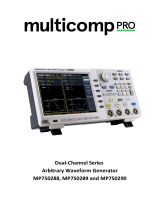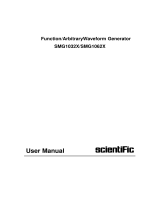Page is loading ...

Arbitrary Function Generator
AFG-125/AFG-225/AFG-125P/AFG-225P
PROGRAMMING MANUAL
GW INSTEK PART NO. 82AF-12500E01
ISO-9001 CERTIFIED MANUFACTURER

This manual contains proprietary information, which is protected by
copyright. All rights are reserved. No part of this manual may be
photocopied, reproduced or translated to another language without
prior written consent of Good Will Corporation.
The information in this manual was correct at the time of printing.
However, Good Will continues to improve its products and therefore
reserves the right to change the specifications, equipment, and
maintenance procedures at any time without notice.
Good Will Instrument Co., Ltd.
No. 7-1, Jhongsing Rd., Tucheng Dist., New Taipei City 236, Taiwan.

Table of Contents
Table of Contents
SAFETY INSTRUCTIONS.................................. 7
Safety Symbols .......................................................................7
Safety Guidelines....................................................................8
GETTING STARTED........................................ 11
Main Features ...................................................................11
Panel Overview..................................................................13
Front Panel ...........................................................................13
Rear Panel.............................................................................14
System Requirements.........................................................15
Software Installation ............................................................15
Setup the Signal Generator..................................................16
Default Settings ................................................................17
REMOTE INTERFACE ..................................... 19
Establishing a Remote Connection ....................................19
Configure USB interface.......................................................19
Remote control terminal connection...................................20
Command Syntax .................................................................21
System Command .............................................................26
SYSTem:ERRor? ...................................................................26
*IDN? ...................................................................................26
*RST .....................................................................................27
SYSTem:VERSion?................................................................27
*OPC ....................................................................................27
*OPC?...................................................................................28
*WAI .....................................................................................28
Status Register Commands ...............................................29
*CLS......................................................................................29
*ESE......................................................................................29
*ESR?....................................................................................30
*STB?....................................................................................30
*SRE .....................................................................................31
Apply Commands ..............................................................32
SOURce[1|2]:APPLy:SINusoid..............................................34
SOURce[1|2]:APPLy:SQUare ................................................34
SOURce[1|2]:APPLy:RAMP...................................................35
3

AFG-200 SERIES USER MANUAL
SOURce[1|2]:APPLy:PULSe.................................................. 35
SOURce[1|2]:APPLy:NOISe.................................................. 36
SOURce[1|2]:APPLy:USER ................................................... 36
SOURce[1|2]:APPLy? ............................................................ 37
Output Commands............................................................38
SOURce[1|2]:FUNCtion ....................................................... 38
SOURce[1|2]:FREQuency ..................................................... 39
SOURce[1|2]:AMPlitude....................................................... 41
SOURce[1|2]:DCOffset......................................................... 42
SOURce[1|2]:SQUare:DCYCle.............................................. 43
SOURce[1|2]:RAMP:SYMMetry............................................ 44
OUTPut[1|2] ......................................................................... 45
OUTPut[1|2]:LOAD .............................................................. 45
SOURce[1|2]:VOLTage:UNIT............................................... 46
Pulse Configuration Commands ........................................48
SOURce[1|2]:PULSe:PERiod ................................................ 48
SOURce[1|2]:PULSe:WIDTh................................................. 49
Amplitude Modulation (AM) Commands...........................50
AM Overview........................................................................ 50
SOURce[1|2]:AM:STATe....................................................... 51
SOURce[1|2]:AM:INTernal:FUNCtion ................................. 51
SOURce[1|2]:AM:INTernal:FREQuency............................... 52
SOURce[1|2]:AM:DEPTh...................................................... 52
Frequency Modulation (FM) Commands............................54
FM Overview........................................................................ 54
SOURce[1|2]:FM:STATe....................................................... 55
SOURce[1|2]:FM:INTernal:FUNCtion ................................. 55
SOURce[1|2]:FM:INTernal:FREQuency ............................... 56
SOURce[1|2]:FM:DEViation................................................. 56
Frequency-Shift Keying (FSK) Commands ..........................59
FSK Overview ....................................................................... 59
SOURce[1|2]:FSKey:STATe................................................... 59
SOURce[1|2]:FSKey:FREQuency .......................................... 60
SOURce[1|2]:FSKey:INTernal:RATE..................................... 61
Phase Modulation (PM)Commands ...................................62
PM Overview........................................................................ 62
SOURce[1|2]:PM:STATe....................................................... 63
SOURce[1|2]:PM:INTernal:FUNction.................................. 63
SOURce[1|2]:PM:INTernal:FREQuency............................... 64
SOURce[1|2]:PM:DEViation................................................. 64
SUM Modulation (SUM) Commands ..............................66
SUM Overview ..................................................................... 66
SOURce[1|2]:SUM:STATe .................................................... 67
4

Table of Contents
SOURce[1|2]:SUM:INTernal:FUNction................................67
SOURce[1|2]:SUM:INTernal:FREQuency.............................68
SOURce[1|2]:SUM:AMPL .....................................................68
Frequency Sweep Commands ............................................70
Sweep Overview ...................................................................70
SOURce[1|2]:SWEep:STATe .................................................71
SOURce[1|2]:FREQuency:STARt ..........................................72
SOURce[1|2]:FREQuency:STOP...........................................72
SOURce[1|2]:FREQuency:CENTer........................................73
SOURce[1|2]:FREQuency:SPAN...........................................74
SOURce[1|2]:SWEep:SPACing..............................................75
SOURce[1|2]:SWEep:TIME...................................................75
SOURce[1|2]:SWEep:SOURce..............................................76
SOURce[1|2]:MARKer:FREQuency.......................................77
SOURce[1|2]:MARKer...........................................................77
Burst Mode Commands.....................................................79
Burst Mode Overview...........................................................79
SOURce[1|2]:BURSt:STATe ..................................................81
SOURce[1|2]:BURSt:MODE .................................................81
SOURce[1|2]:BURSt:NCYCles ..............................................82
SOURce[1|2]:BURSt:INTernal:PERiod .................................83
SOURce[1|2]:BURSt:PHASe .................................................83
SOURce[1|2]:BURSt:TRIGger:SOURce ................................84
SOURce[1|2]:BURSt:TRIGger:DELay....................................85
SOURce[1|2]:BURSt:TRIGger:SLOPe...................................86
SOURce[1|2]:BURSt:GATE:POLarity ....................................86
SOURce[1|2]:BURSt:OUTPut:TRIGger:SLOPe ....................87
SOURce[1|2]:BURSt:OUTPut[1|2]:TRIGger..........................88
Arbitrary Waveform Commands .........................................89
Arbitrary Waveform Overview..............................................89
SOURce[1|2]:FUNCtion USER .............................................90
SOURce[1|2]:DATA:DAC ......................................................90
SOURce[1|2]:ARB:EDIT:COPY .............................................91
SOURce[1|2]:ARB:EDIT:DELete ...........................................92
SOURce[1|2]:ARB:EDIT:DELete:ALL ....................................92
SOURce[1|2]:ARB:EDIT:POINt.............................................92
SOURce[1|2]:ARB:EDIT:LINE...............................................93
SOURce[1|2]:ARB:EDIT:PROTect.........................................93
SOURce[1|2]:ARB:EDIT:PROTect:ALL .................................94
SOURce[1|2]:ARB:EDIT:UNProtect......................................94
SOURce[1|2]:ARB:OUTPut...................................................94
Phase ................................................................................95
SOURce[1|2]:PHASe.............................................................95
SOURce[1|2]:PHASe:SYNChronize......................................95
5

AFG-200 SERIES USER MANUAL
6
Couple...............................................................................96
SOURce[1|2]:FREQuency:COUPle:MODE .......................... 96
SOURce[1|2]:FREQuency:COUPle:OFFSet.......................... 96
SOURce[1|2]:FREQuency:COUPle:RATio ............................ 97
SOURce[1|2]:AMPlitude:COUPle:STATe ............................. 97
SOURce[1|2]:TRACk ............................................................. 97
Sync ..................................................................................99
OUTPut:SYNC...................................................................... 99
OUTPut[1|2]:SYNC:MODE .................................................. 99
OUTPut[1|2]:SYNC:POLarity.............................................. 100
OUTPut:SYNC:SOURce..................................................... 101
Power Commands............................................................102
VOUTput ............................................................................ 102
VSET ................................................................................... 102
Save and Recall Commands .............................................104
*SAV................................................................................... 104
*RCL ................................................................................... 104
MEMory:STATe:DELete ..................................................... 104
MEMory:STATe:DELete ALL .............................................. 105
Error Messages................................................................106
Command Error Codes...................................................... 106
Execution Errors................................................................. 108
Query Errors....................................................................... 115
Arbitrary Waveform Errors................................................. 115
SCPI Status Register........................................................117
Register types..................................................................... 117
AFG-200 SERIES Status System ........................................ 118
Questionable Status Register ............................................ 119
Standard Event Status Registers ....................................... 119
The Status Byte Register .................................................... 121
Output Queue.................................................................... 122
Error Queue........................................................................ 122
APPDENIX.................................................... 123
AFG-200 Specifications....................................................123

TABLE OF CONTENTS
SAFETY INSTRUCTIONS
This chapter contains important safety instructions
that should be followed when operating and
storing the function generator. Read the following
before any operation to ensure your safety and to
keep the function generator in the best condition.
Safety Symbols
These safety symbols may appear in this manual or on the
instrument.
WARNING Warning: Identifies conditions or practices that
could result in injury or loss of life.
CAUTION Caution: Identifies conditions or practices that
could result in damage to the function generator or
to other objects or property.
DANGER High Voltage
Attention: Refer to the Manual
Protective Conductor Terminal
Earth (Ground) Terminal
DANGER Hot Surface
7

AFG-200 SERIES USER MANUAL
Double Insulated
Do not dispose electronic equipment as unsorted
municipal waste. Please use a separate collection
facility or contact the supplier from which this
instrument was purchased.
Safety Guidelines
General
Guideline
CAUTION
• Do not place heavy objects on the instrument.
• Do not place flammable objects on the
instrument.
• Avoid severe impact or rough handling that
may damage the function generator.
• Avoid discharges of static electricity on or near
the function generator.
• Use only mating connectors, not bare wires, for
the terminals.
• The instrument should only be disassembled by
a qualified technician.
Power Supply
WARNING
• DC Input voltage: 5V/2A.
• Do not exceed an input voltage of 5V±5%.
Fuse
WARNING
• Fuse type: F3.15A/125V.
• Only qualified technicians should replace the
fuse.
• To ensure fire protection, replace the fuse only
with the specified type and rating.
• Disconnect the power and all test leads before
replacing the fuse.
• Make sure the cause of fuse blowout is fixed
before replacing the fuse.
8

AFG-200 SERIES USER MANUAL
Cleaning the
function
generator
• Disconnect the power cord before cleaning the
function generator.
• Use a soft cloth dampened in a solution of mild
detergent and water. Do not spray any liquid
into the function generator.
• Do not use chemicals containing harsh products
such as benzene, toluene, xylene, and acetone.
Operation
Environment
• Location: Indoor, no direct sunlight, dust free,
almost non-conductive pollution (Note below)
and avoid strong magnetic fields.
• Relative Humidity: < 80%
• Altitude: < 2000m
• Temperature: 0°C to 40°C
(Pollution Degree) EN 61010-1:2010 specifies pollution degrees and
their requirements as follows. The function generator falls under
degree 2.
Pollution refers to “addition of foreign matter, solid, liquid, or
gaseous (ionized gases), that may produce a reduction of dielectric
strength or surface resistivity”.
• Pollution degree 1: No pollution or only dry, non-conductive
pollution occurs. The pollution has no influence.
• Pollution degree 2: Normally only non-conductive pollution
occurs. Occasionally, however, a temporary conductivity caused
by condensation must be expected.
• Pollution degree 3: Conductive pollution occurs, or dry,
non-conductive pollution occurs which becomes conductive due
to condensation which is expected. In such conditions,
equipment is normally protected against exposure to direct
sunlight, precipitation, and full wind pressure, but neither
temperature nor humidity is controlled.
Storage
environment
• Location: Indoor
• Relative Humidity: < 70%
• Temperature: -10°C ~ 70°C
9

AFG-200 SERIES USER MANUAL
Disposal
Do not dispose this instrument as unsorted
municipal waste. Please use a separate collection
facility or contact the supplier from which this
instrument was purchased. Please make sure
discarded electrical waste is properly recycled to
reduce environmental impact.
10

AFG-200 SERIES USER MANUAL
GETTING STARTED
The Getting started chapter introduces the
function generator’s main features, appearance
and introduces a quick instructional summary of
some of the basic functions. For comprehensive
operation instructions, please see the operation
chapter.
Main Features
Model AFG-125 AFG-125P AFG-225 AFG-225P
Frequency Range 1uHz-25MHz
Output Channels 1 1 2 2
Power Output None Yes None Yes
Performance • DDS signal generator
• 1μHz resolution over the full range
• 20ppm frequency stability
• Arbitrary Waveform Capability
120 MSa/s sample rate
60 MSa/s repetition rate
4 k-point waveform length
4k waveform memory, 10 groups
User-defined output
DWR (Direct waveform reconstruction) capability
PC waveform editing
Features • Sine, Square, Ramp, Pulse & Noise as standard
waveforms
• Internal LIN/LOG sweeps with marker output
• AM, FM, FSK, SUM modulation
• Triggered burst function
• Save/recall 10 setup memories
• Output overload protection
11

AFG-200 SERIES USER MANUAL
Interface • USB interface as standard
• AWES (arbitrary waveform editing software) PC
software
Power Supply
(AFG-125P/
225P only)
• 2.5V/3.3V/5V supply output
• 0.6A current output
12

AFG-200 SERIES USER MANUAL
Panel Overview
Front Panel
These LEDs indicate the immediate
status of the power supply function
on the AFG-125P/225P:
2.5V 2.5V output is on
3.5V 3.5V output is on
5V 5V output is on
Power Supply
Status LEDs
OVER LOAD Overload condition
Negative Output
Negative output port
GND Ground port
Positive Output
Positive output port
SYNC
S
Y
N
C
Sync output. A TTL signal is output
as the sweep marker or sync output
signal.
CH1
C
H
1
50Ω
CH1 (Signal 1) output.
13

AFG-200 SERIES USER MANUAL
CH2
50Ω
C
H
2
CH1 (Signal 2) output
(AFG-225/AFG-225P only).
Rear Panel
2A MAX.
DC 5V
INPUT
Vent USB Device Port Input Power
Vent Cooling vent.
USB Device Port
Interfaces with the GDS-2000A and
can also provide power.
Input Power
Input power source:
DC 5V; 2A max.
14

AFG-200 SERIES USER MANUAL
System Requirements
Operating System Microsoft Windows XP
Microsoft Windows 7
Microsoft Windows Vista
CPU 300MHz
Memory 256MB
Hard Disk Space 100MB
Supports
USB2.0(compatible
with USB1.1)
The USB 2.0 Universal Serial Bus specification is
supported with transfer rates from USB1.1 to
USB2.0.
Software Installation
Close all the programs that are currently running.
Insert the included installation CD into your CD-ROM drive, and
execute the following steps:
1. Execute the installer on the CD. Install the software step by step
by following the prompts.
2. Connect hardware after the installation is completed. The
computer will automatically search for the new hardware and
install its driver. You can start to use the signal generator after
the driver is installed.
15

AFG-200 SERIES USER MANUAL
Setup the Signal Generator
PC
Communication
1. Plug the power adapter into
the power input port on the
rear panel.
2. Connect the type B end of
the accessory USB cable to
the USB B port on the signal
generator, and then connect
the type A end of the USB
cable to the USB A port on
the computer.
3. Turn on the PC and control the signal generator
through the PC software.
The signal generator is ready for use.
16

AFG-200 SERIES USER MANUAL
Default Settings
The command *RST is used to restore the default
panel settings.
*RST
Output Settings Function Sine Wave
Frequency 1kHz
Amplitude 1.000 Vpp
Offset 0.00V dc
Output units Vpp
Output terminal 50Ω
Power OFF
Sync OFF
Modulation
(AM/FM/FSK/
PM/SUM) Carrier wave 1kHz sine wave
Modulation wave 100Hz sine wave
AM depth 100%
FM deviation 100Hz
FSK hop frequency 100Hz
FSK frequency 10Hz
PM phase deviation 180˚
SUM amplitude 50%
Modem status Off
Sweep Start/Stop frequency 100Hz/1kHz
Sweep time 1s
Sweep type Linear
17

AFG-200 SERIES USER MANUAL
Sweep status Off
Burst Burst frequency 1kHz
Ncycle 1
Burst period 10ms
Burst starting phase 0˚
Burst status Off
System Settings Power off signal On
Error queue Cleared
Memory settings No change
Output Off
18

AFG-200 SERIES USER MANUAL
REMOTE INTERFACE
Establishing a Remote Connection ....................................19
Configure USB interface.......................................................19
Remote control terminal connection...................................20
Command Syntax .................................................................21
Establishing a Remote Connection
The AFG-200 supports USB remote connections
Configure USB interface
PC side connector
USB
configuration AFG-200 series
side connector
Type B, slave
Speed
1.1/2.0 (full speed)
Panel Operation 1. Connect the USB cable to the
rear panel USB B (slave) port.
2. When the PC asks for the
USB driver, select
XXXXXXX.inf included in the
software package or
download the driver from the
GW website,
www.gwinstek.com.
19

AFG-200 SERIES USER MANUAL
Remote control terminal connection
Termi nal
application
Invoke the terminal application such as MTTTY
(Multi-Threaded TTY). For USB, set the COM port,
baud rate, stop bit, data bit, and parity
accordingly.
To check the COM port No, see the Device
Manager in the PC. For WinXP, Control panel →
System → Hardware tab.
Functionality
check
Run this query command via the terminal.
*idn?
This should return the Manufacturer, Model
number, Serial number, and Firmware version in
the following format.
GW INSTEK, AFG-X25X, SN:XXXXXXXX,Vm.mm
Note: ^j or ^m can be used as the terminal
character when using a terminal program.
PC Software
The proprietary PC software, downloadable from
GWInstek website, can be used for remote control.
20
/



